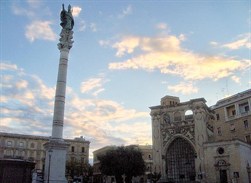Piazza Sant’Oronzo and Bishop Luigi Pappacoda’s power
At the time of his entry into Lecce as the new bishop, on 4 December, 1639, Monsignor Luigi Pappacoda found a diocese suffering from numerous problems and inefficiencies. The long episcopate (1591-1639) of Scipione Spina, who died at the age of over ninety, had relegated the figure of the bishop to a role of total subordination, both against the secular powers (governor, preside of the Province and mayor of the city) both within the ecclesiastical world, with respect to the influence and prestige of the many Religious Orders within the city. Pappacoda’s commitment to attempt to radically change this situation by making of the bishop the main reference point for the city, was destined to forever change the face of Lecce. During his long episcopate (1639-1670), Pappacoda strove successfully to implement the Tridentine reforms in the diocese of Lecce, but that had not been implemented under the guidance of his predecessors. He vigorously defended the independence of his power against the secular authorities and the claims of the barons. He also tried to reform the mores of the local clergy, to improve their doctrinal and cultural training so as to limit the diaconi selvaggi (the savage deacons), or the married priests who populated the diocese. His charisma and prestige were sufficient to prevent Lecce from being affected by the revolutionary wave which had begun in Naples in the years 1647-1648, as took place in other Apulian cities.
 The most evocative symbol of Pappacoda’s power is perhaps the ability with which imposed the cult of the new patron saint, Saint Orontius, who was considered the one who has spared Lecce from the plague which spread throughout southern Italy in 1656. The cult of Saint Orontius also marked an important victory for the bishop in his personal struggle with the Theatine Order, the main promoters of the previous patroness, Saint Irene. In current day Lecce, Piazza Sant’Oronzo continues to be a testimony to Pappacoda’s success and his desire to change the face of the city. Next to the Roman amphitheatre, a symbol of the ancient history of Lecce and the Sedile, the seat of the municipal administration until the nineteenth century, the Column of Sant’Oronzo is one of the most representative monuments of the city and its Baroque soul. Commissioned to Giuseppe Zimbalo, the sculptor who, more than anyone else, would link his name to that of Pappacoda and Lecce in those years, the column was built using the remains of one of the terminal columns of the Roman Via Appia in Brindisi. Zimbalo designed and built the base and reworked the shaft and the capital. The statue of the saint which was later placed on top of the column was more than 4 metres high and made in Venice. Along with the statue, the column reaches a height of almost 29 metres.
The most evocative symbol of Pappacoda’s power is perhaps the ability with which imposed the cult of the new patron saint, Saint Orontius, who was considered the one who has spared Lecce from the plague which spread throughout southern Italy in 1656. The cult of Saint Orontius also marked an important victory for the bishop in his personal struggle with the Theatine Order, the main promoters of the previous patroness, Saint Irene. In current day Lecce, Piazza Sant’Oronzo continues to be a testimony to Pappacoda’s success and his desire to change the face of the city. Next to the Roman amphitheatre, a symbol of the ancient history of Lecce and the Sedile, the seat of the municipal administration until the nineteenth century, the Column of Sant’Oronzo is one of the most representative monuments of the city and its Baroque soul. Commissioned to Giuseppe Zimbalo, the sculptor who, more than anyone else, would link his name to that of Pappacoda and Lecce in those years, the column was built using the remains of one of the terminal columns of the Roman Via Appia in Brindisi. Zimbalo designed and built the base and reworked the shaft and the capital. The statue of the saint which was later placed on top of the column was more than 4 metres high and made in Venice. Along with the statue, the column reaches a height of almost 29 metres.
